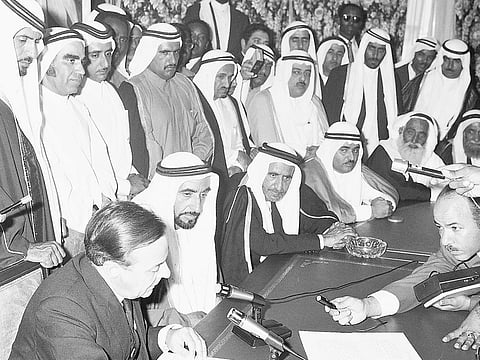UAE National Day: 7 key facts about how the UAE was formed
Key moments, decisions, and challenges that led to the creation of the UAE in 1971

Dubai: Every year, the UAE comes alive on December 2 with fireworks, flags, and nationwide celebrations for Eid Al Etihad. Behind the colours and concerts lies a deeper story of bold leadership, difficult negotiations, and a shared belief that seven separate emirates could be stronger as one.
The creation of the Union in 1971 was not guaranteed, it was the result of historic meetings and decisive choices that shaped the UAE. This is the story of how the emirates came together, why it mattered, and how that decision shaped the UAE we know today.
1. The Trucial States and British Protection before the UAE
Before the establishment of the United Arab Emirates in 1971, the region was known as the Trucial States, a group of independent sheikhdoms along the Arabian Gulf coast. These included Abu Dhabi, Dubai, Sharjah, Ajman, Umm Al Quwain, Fujairah and Ras Al Khaimah.
In 1892, the Trucial States signed a treaty with the British Government that placed them under British protection. While they were not formally absorbed into the British Empire, Britain assumed responsibility for defence by land and sea. In return, the Trucial States could not cede territory or enter into agreements with other foreign powers without British consent.
2. Oil discovery and the push for unity
The discovery of oil in Abu Dhabi in 1962, followed by Dubai and Sharjah, transformed the region economically and politically. Rapid development followed, but so did a growing sense that unity was essential for long-term stability and independence.
This desire intensified in early 1968 when Britain announced it would withdraw from the Gulf by the end of 1971 due to economic pressures. The decision created uncertainty and raised concerns of a political and security vacuum.
3. Sheikh Zayed and the vision for a union
For the late Sheikh Zayed bin Sultan Al Nahyan, the UAE’s Founding Father, the British withdrawal was not a setback but an opportunity. Having assumed leadership of Abu Dhabi in 1966, he believed deeply that the emirates shared common history, culture and destiny.
The vision of a federation was influenced by the wider Pan-Arab unity movement and driven by the practical need to protect the region from external ambitions. A united federation, he believed, would give the emirates strength, stability and international standing.
4. The historic Abu Dhabi–Dubai agreement
On February 18, 1968, Sheikh Zayed met with Sheikh Rashid bin Saeed Al Maktoum, the late Ruler of Dubai at Al Samha, near today’s Abu Dhabi–Dubai border. At this historic meeting, they agreed to:
Merge the respective Emirates into a union
Jointly handle foreign affairs, defence, security and social services
Introduce a common immigration policy
This agreement became known as the Union Accord, the first decisive step toward forming the UAE.
5. Attempts at a nine-state federation
The two leaders invited the rulers of the remaining five Trucial States, along with Bahrain and Qatar, to join talks for a broader federation. This would have created a nine-state union.
From February 25 to 27, 1968, the nine rulers met in Dubai and agreed on 11 key principles that would form the basis of a proposed “Federation of the Arab Emirates.” However, political and regional differences later led Bahrain and Qatar to pursue independent paths.
6. From six-state agreement to the birth of the UAE
By mid-1971, an alternative plan took shape. On July 18, 1971, the rulers of Abu Dhabi, Dubai, Sharjah, Ajman, Umm Al Quwain, Fujairah agreed to form a new federation. Ras Al Khaimah was still undecided at the time.
On December 2, 1971, the United Arab Emirates was formally proclaimed a sovereign nation. Ras Al Khaimah officially joined the federation on February 10, 1972, completing the union of seven Emirates.
The country became officially known as Dawlat Al Imarat Al Arabiyya Al Muttahida – the United Arab Emirates (UAE).
7. The creation of the UAE Constitution
A Provisional Constitution was adopted based on amended drafts prepared during earlier negotiations. It consisted of 152 articles, setting out the structure of the federal government while allowing individual Emirates to retain local authority.
The Constitution created five central authorities:
Supreme Council of the Union – made up of the seven rulers, and the highest legislative and executive authority
President and Vice President
Council of Ministers (Cabinet)
Federal National Council (FNC) – a 40-member consultative body representing all Emirates
Federal Judiciary, led by the Federal Supreme Court
A federal state that defied the odds
Sheikh Zayed’s vision laid the foundation for a nation that is today politically stable, economically resilient and socially cohesive. The UAE remains the only successful federal system in the Arab world to have endured and flourished over time.
The UAE today
More than five decades after its formation, the UAE stands as one of the most remarkable nation-building stories of the modern era. What began in 1971 as a bold political experiment between seven small Emirates has grown into a stable, secure and globally influential country.
It is now widely recognised for its low crime rates, strong institutions and high standard of living, and is home to millions of residents representing more than 200 nationalities.
Economically, the nation has travelled far beyond its early dependence on oil, with non-oil sectors now contributing over three-quarters of GDP. Just as significantly, it has emerged as a place of coexistence, tolerance and opportunity, where different cultures and faiths live side by side.
The UAE’s journey reflects the power of vision, unity and determination. It is no longer just a federation that survived, it is a nation that thrived, adapted and succeeded on its own terms.
Important note: The historical information and facts in this article are sourced from the UAE’s National Library and Archives - www.nla.ae
Sign up for the Daily Briefing
Get the latest news and updates straight to your inbox



